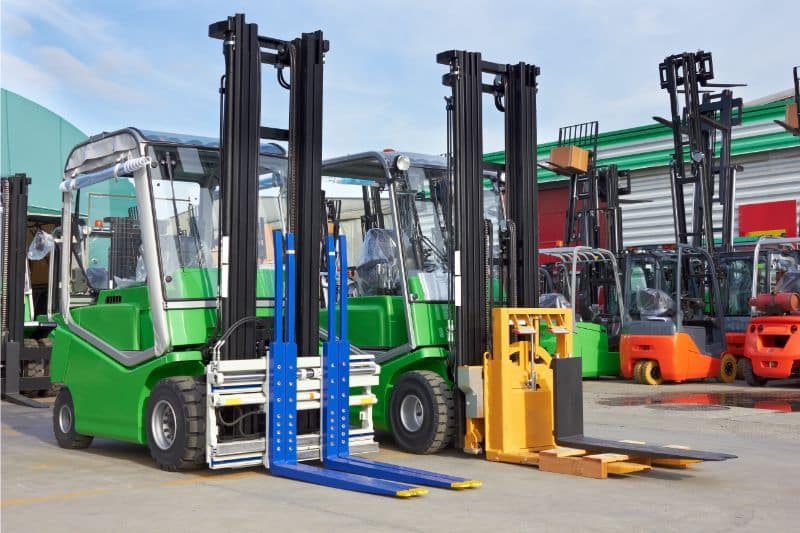Forklift machines are an essential vehicle on construction sites. The different types of forklifts move heavy loads around the site safely and quickly.
3 Types of Power for Forklift Machines
There are three types of power available in a forklift. Do you need one on site running all day? Do you need a more powerful motor but only for short jobs? The nature of the job will determine what sort of power you need in a forklift.
Electric Powered Forklifts

Eco-friendly, quiet and reliable, electric powered forklifts models are strong and durable. They tend to be the smallest forklift models. They are highly manoeuvrable and tend to have lower maintenance costs. Their lifting capacity is 1000–3500 kgs.
LPG/Petrol Powered Forklifts
LPG forklift models are versatile performers that combine excellent fuel economy with low emissions. These are ideal if you need a forklift powered to operate all day as they don’t need recharging, just replacing the gas bottle. They can load and transport goods across sites and can carry 1000–7000 kgs.
Diesel Powered Forklifts
Diesel powered forklift models are built tough and are designed to carry a huge variety of loads. They are ideal for heavy duty outdoor work. They are the best powered forklift models for working on sloping ground and are faster at accelerating and lifting.
They are far more fuel efficient and last longer than LPG models. Of the different types of forklift, they are the strongest workhorses with a lifting capacity of 1000–10,000 kgs.
Different Types of Forklifts
The following guide covers different types of forklifts so that you can choose the most appropriate forklift for each situation.
Pallet Jacks

Pallet jacks (also known as pallet pumps, pallet trucks or pump trucks) are the most basic type of forklift. Pallet jacks are armed with two tynes that are designed to lift and move pallets up to 2500 kgs.
Their lack of power is counterbalanced by their manoeuvrability as pallet jacks are able to squeeze into small spaces such as a narrow aisle.
Stackers
Unlike other types of forklifts, stackers don’t have a driver in a cab. The operator walks behind the machine and steers it with a handle.
Order pickers are a type of stacker. If you need a taller pallet jack, a stacker is ideal as it can reach up to 3500 metres.
They are manoeuvrable, durable, smooth to operate and have low running costs. Some are as thin as 1.5 metres, making them also suitable for lifting in a narrow aisle. Their lift capacity is 1200–2000 kgs.
Side Loaders
Side loaders are designed to carry long loads such as timber planks or steel pipes. Drivers operate from a compartment sideway to the tynes of the forklift, giving them better visibility and safety without having to turn.
Long loads are more readily transported as the length is pointing in the direction of travel, reducing the width, especially in a narrow aisle, and ensuring safer movement. They can lift up to 4500 kgs.
To find out more about the key forklift safety tips check out our recent article.
Reach Trucks

This forklift truck is built to operate in narrow spaces between aisles and walls. A reach truck moves its tynes forward, allowing it to reach into confined areas with great precision. The load then moves within the wheelbase area, so less of the load overhangs the forklift truck.
The open compartment gives the driver greater visibility. Reach trucks are not suitable for outdoor work due to their minimal undercarriage clearance. They can lift 40,000–50,000 kgs.
Counterbalance Forklifts
Counterbalance forklifts are the most popular types of forklifts. A steel heavy weight at the back of counterbalance forklifts provides a counterbalance so that heavier loads can be lifted.
Three-wheel counterbalance forklifts can turn in circles. Constructed up to 4000 metres high, they have a carrying capability of 32,000 kgs.
Telehandlers

Of all the different types of forklift models around, telehandlers (also known as telescopic handlers) are probably one of the most useful vehicles on a construction site. Telehandlers combine a forklift with a crane with a boom and extendable arm.
Standard telehandlers can be as tall as 16 metres, have the capacity to lift 2500 kgs up to 6 metres high and are designed to fit into odd angles and tight spaces.
Rough Terrain Forklifts
Rough terrain forklifts are the perfect workhorse for a construction project. They are designed and built specifically for heavy duty outdoor use.
Rough terrain forklifts have four wheels with pneumatic, oversized, threaded tyres. These provide stability and strength over uneven or rocky ground.
At over 3 metres long, they can lift nearly 4000 kg loads. A number of attachments such as pivoted booms or vertical masts allow them to carry materials such as stacks of of wood, roof beams and concrete blocks.
Container Handlers
Container handlers are purpose-built for carrying containers to and from commercial trucks. They have a carrying capability of up to 50,000 kgs and are the only type of forklift able to carry such heavy loads.
The different types of forklift can be operated by one person with the right licences and training.
For the right advice on forklift operators and forklifts, from pallet jacks to reach trucks, call Fast Labour Hire on (03) 9001 6541 or email us at info@fastlabourhire.com.au.

